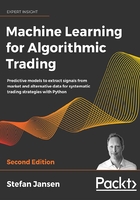
3 Alternative Data for Finance – Categories and Use Cases
The previous chapter covered working with market and fundamental data, which have been the traditional drivers of trading strategies. In this chapter, we'll fast-forward to the recent emergence of a broad range of much more perse data sources as fuel for discretionary and algorithmic strategies. Their heterogeneity and novelty have inspired the label of alternative data and created a rapidly growing provider and service industry.
Behind this trend is a familiar story: propelled by the explosive growth of the internet and mobile networks, digital data continues to grow exponentially amid advances in the technology to process, store, and analyze new data sources. The exponential growth in the availability of and ability to manage more perse digital data, in turn, has been a critical force behind the dramatic performance improvements of machine learning (ML) that are driving innovation across industries, including the investment industry.
The scale of the data revolution is extraordinary: the past 2 years alone have witnessed the creation of 90 percent of all data that exists in the world today, and by 2020, each of the 7.7 billion people worldwide is expected to produce 1.7 MB of new information every second of every day. On the other hand, back in 2012, only 0.5 percent of all data was ever analyzed and used, whereas 33 percent is deemed to have value by 2020. The gap between data availability and usage is likely to narrow quickly as global investments in analytics are set to rise beyond $210 billion by 2020, while the value creation potential is a multiple higher.
This chapter explains how inpiduals, business processes, and sensors produce alternative data. It also provides a framework to navigate and evaluate the proliferating supply of alternative data for investment purposes. It demonstrates the workflow, from acquisition to preprocessing and storage, using Python for data obtained through web scraping to set the stage for the application of ML. It concludes by providing examples of sources, providers, and applications.
This chapter will cover the following topics:
- Which new sources of information have been unleashed by the alternative data revolution
- How inpiduals, business processes, and sensors generate alternative data
- Evaluating the burgeoning supply of alternative data used for algorithmic trading
- Working with alternative data in Python, such as by scraping the internet
- Important categories and providers of alternative data
You can find the code samples for this chapter and links to additional resources in the corresponding directory of the GitHub repository. The notebooks include color versions of the images.